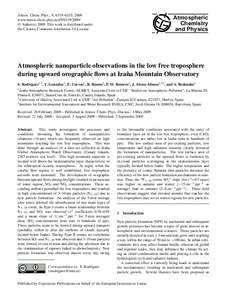Por favor, use este identificador para citar o enlazar este ítem:
http://hdl.handle.net/20.500.11765/393
Atmospheric nanoparticle observations in the low free troposphere during upward orographic flows at Izaña Mountain Observatory
| Título : | Atmospheric nanoparticle observations in the low free troposphere during upward orographic flows at Izaña Mountain Observatory |
| Autor : | Rodríguez González, Sergio










|
| Palabras clave : | Atmospheric nanoparticle; Low free troposphere; Orographic flows; Nanopartículas; Troposfera; Flujo orográfico |
| Fecha de publicación : | 2009 |
| Editor: | European Geosciences Union |
| Citación : | Atmospheric Chemistry and Physics, 2009, 9(17), p. 6319-6335 |
| Versión del editor: | https://dx.doi.org/10.5194/acp-9-6319-2009 |
| Resumen : | This study investigates the processes and conditions favouring the formation of nanoparticles (diameter<10 nm) which are frequently observed on high mountains reaching the low free troposphere. This was done through an analysis of a data set collected at Izaña Global Atmospheric Watch Observatory (Canary Islands; 2367 m above sea level). This high mountain supersite is located well above the stratocumulus layer characteristic of the subtropical oceanic tropospheres. At night, when the catabic flow regime is well established, free troposphere aerosols were measured. The development of orographic buoyant upward flows during daylight resulted in an increase of water vapour, SO2 and NOy concentrations. These ascending airflows perturbed the free troposphere and resulted in high concentrations of 3–10 nm particles (N3–10) due to new particle formation. An analysis of the 5-min average time series allowed the identification of two main types of N3–10 event. In Type I events a linear relationship between N3–10 and SO2 was observed (r2 coefficients 0.70–0.95 and a mean slope of 11 cm−3 ppt−1 for 5-min averaged data; SO2 concentrations from tens to hundreds of ppt). These particles seem to be formed during upward transport (probably within or after the outflows of clouds typically located below Izaña). |
| URI : | http://hdl.handle.net/20.500.11765/393 |
| ISSN : | 1680-7316 1680-7324 |
| Colecciones: | Artículos científicos 2005-2009 |
Ficheros en este ítem:
| Fichero | Descripción | Tamaño | Formato | ||
|---|---|---|---|---|---|
| acp-9-6319-2009.pdf | 1,96 MB | Adobe PDF |  Visualizar/Abrir |
Este ítem está sujeto a una licencia Creative Commons Licencia Creative Commons






